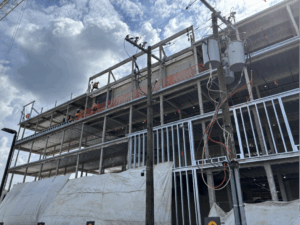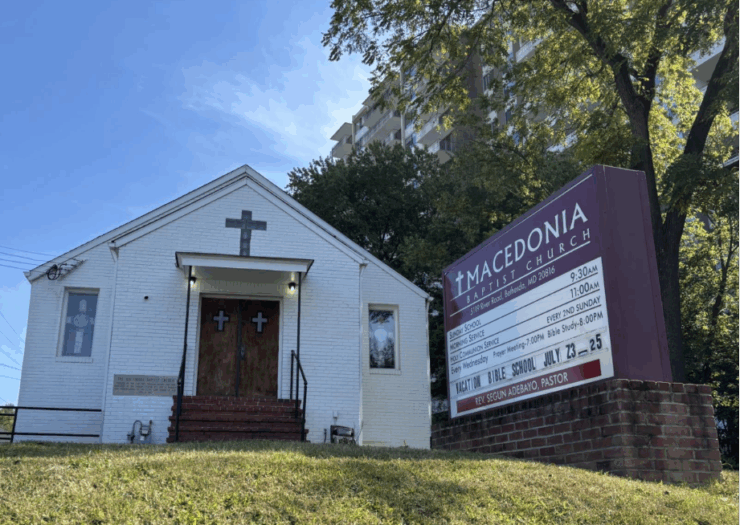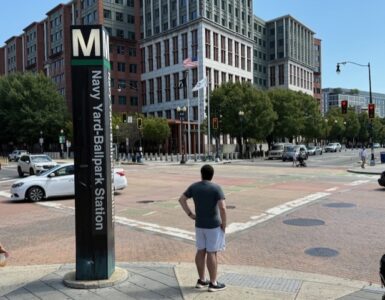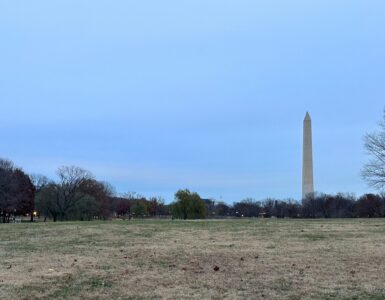Local activists are scrambling to stop the construction of a self-storage facility on Bethesda land that could be part of a historic African cemetery.
The Bethesda African Cemetery Coalition filed a lawsuit in August 2024 to bar developers 1784 Capital Holdings LLC from building on property the coalition says could have hundreds of enslaved people’s bones. Montgomery County Circuit Judge Carlos Acosta ruled in late August that the coalition has until February to finish discovery so court hearings can proceed on schedule.
“This, just like every case that comes here, is an important case. It’s not just important to the parties involved. It’s important to a lot of people in the community,” Acosta said at an August court hearing.
Acosta denied a motion by the Arizona-based developers to dismiss the lawsuit, calling it “premature.”
The developers maintain there is no evidence of human remains on the property.
“It’s just rhetoric,” said Jarvis Stewart, who owns a communications firm that represents 1784.
“It’s just vicious, calling my client the most horrible names – racists and bigots – with no proof.”
Stewart said the company recovered multiple bone fragments during the excavation process, but archeologists they hired determined they were animal bones.

The discoveries were removed from the site, stored for over one year, then tested for human DNA multiple times, Stewart said.
During the DNA testing process, the bones were destroyed.
To test for human DNA, according to a court affidavit, a forensic analyst smashed the bones “into a fine powder.”
Marsha Coleman-Adebayo, who founded the Bethesda African Cemetery Coalition, called the removal and subsequent destruction of the bones “one of the crimes of the century.”
She said the bones are human and belong to Bethesda’s African ancestors.
“That was their only means of communicating with future generations, with their bones. Those bones would have told the story of what happened to them,” she told The Wash.
“When you assume the arrogance of destroying someone’s ability to tell their story, that is vile and despicable.”
Bethesda’s African history
In the early 1800s, nearly 50% of the people in Montgomery County were enslaved African Americans, Bethesda historian Hank Levine said.
After the U.S. emancipated slaves, many African Americans left Bethesda.
Some stuck around.
“After the Civil War, free Black people were able to purchase land in some areas, including along River Road. That becomes a Black neighbor,” Levine said. “They built a church. It’s still there.”
That church is Macedonia Baptist Church. It is the only remaining building from the Black neighborhood on River Road.
Coleman-Adebayo’s husband is the pastor. She said that’s how she first learned of Moses African Cemetery.
One of the congregation members, Harvey Matthews, said he used to play at the cemetery as a little boy in the 1950s.
The developers don’t argue that the cemetery existed, but there is debate over where the boundary is.
Developers discover bones on property
The developer 1784 originally bought multiple adjacent parcels of land for $11 million in 2017, according to Montgomery County land records.
In the early stages of construction, the company found “artifacts” and other things “related to early 1900s grave sites” on one parcel, Stewart said.
The company deeded that land back to the county.
Construction continued on the adjacent section of property and is ongoing today. That’s the piece of land where 1784 recovered what company officials said were “animal bones.”
Boyd Sipe is an archeologist at Wetland Studies and Solutions Inc., the company 1784 hired to oversee the archeological excavation on site.
In a sworn court affidavit, he said “no human remains or funerary objects were found on the property.”
Multiple archeologists have examined the recovered bones.
In an email to Sipe, Towson University professor Dana Kollmann, a forensic archeologist, said she could not conclude that recovered bone fragments were “conclusively non-human” without DNA testing.
Coleman-Adebayo said that is important evidence that points to needing more conclusive examination.
After that email, 76 of the 132 recovered bones fragments were tested for human DNA.

Of the 76 bone samples tested, 74 had DNA levels “below the limit of detection,” according to court fillings from March.
Of the remaining two samples, only one showed evidence of human DNA, according to a report from Benetta George, the DNA analyst who did the testing. She attributed the trace amounts of human DNA to possible contamination during the transportation and testing process.
That’s not conclusive for Coleman-Adebayo. The recovered bones are likely human, she said.
So far, experts paid by the developers have done all the DNA testing on recovered artifacts. Court filings said 1784 spent $331,058 on archeologic services from Wetland Studies.
Coleman-Adebayo said the coalition needs access to what is left of the recovered bones so they can perform their own analysis.
She said there might be a different kind of test that can produce conclusive results with the trace amounts of DNA left on the bone fragments.
The land being built on had the perfect conditions to be a mass grave, Coleman-Adebayo said.
“That was swamp. It was just an incredible amount of water. Because it was agriculturally unproductive, it was environmentally perfect to be used as a mass burial because you couldn’t do anything else with it,” she said.
She said the bodies of Africans who were kidnapped and brought to the U.S. to be slaves were likely thrown in that mass grave.
The coalition recovered over 30 “funerary artifacts” from construction site dirt, Coleman-Adebayo said, which builders dumped at a landfill.
Those artifacts include scraps of fabric and bottles, which Coleman-Adebayo said points to funeral activity because African cultures often place bottles on grave sites to protect the spirit of the dead.
Tammy Hilburn, a cultural property crime expert, volunteered to monitor the construction site with the Bethesda African Cemetery Coalition. During those observations, she said there was minimal oversight from the developers’ archeologists.
She observed an object on top of a “freshly excavated” pile of dirt and took a photo. Later, when reviewing her pictures, she said “it was evident … that object was a tombstone,” according to court documents filed by the coalition.
Stewart said anything recovered from the site is normal waste from “people living their lives,” not an indication of funeral activities.
“The property we are currently building on does not have any artifacts or any tombstones and all this other stuff that the coalition is suggesting,” he said.
What happens next?
Although the judge granted Bethesda African Cemetery Coalition until February to prove there are human remains on the development site, construction doesn’t have to stop.
Stewart said the projected completion date of the project is Spring 2026.
The company recently filed a countersuit in Montgomery County Circuit Court against the coalition to stop the group from interfering with construction. Judge Acosta postponed that ruling until after discovery is finished.
Stewart said the company recognizes Montgomery County’s history of “highly regarded, highly respected African American communities.” That’s why 1784 promised $250,000 to paint a mural honoring Bethesda’s African American population on a retaining wall near the storage facility.
The coalition isn’t interested in compromise, Stewart said.
“They want the land. They’ve wanted the land from the very beginning,” he said.
Coleman-Adebayo said winning the court battle would “stop the ongoing desecration” of Moses African Cemetery.
To prove the land is part of the cemetery, the coalition will hire its own experts to survey the property and examine any recovered artifacts. That will include DNA testing of the bones 1784 recovered from the site, Coleman-Adebayo said.
Ideally, she said, the coalition and Macedonia Baptist Church would partner to control the land and build a museum telling the history of the River Road community.
“We’d like to turn that area into a sacred space where people from all over the world can come, not to store their refrigerators and couches, but to understand the horror of what we call European barbarism,” Coleman-Adebayo said.















There’s a company in New Hampshire called Topographix Cemetery Mapping Ground Penetrating Radar Services. They have an excellent record in locating unmarked graves. They even published a book on Mapping and locating Graves.
Why not consult them for their GPR services.
Excellent Job Ms. Staton. You obtained a startling admission- that they destroyed evidence. Your work is now “Exhibit A”.
I recall reading from previous articles that bone fragments found at the site were small and very delicate. In my experience, advanced DNA testing would have been intrusive and likely destroyed fragments in the process. No startling revelation or admission here.